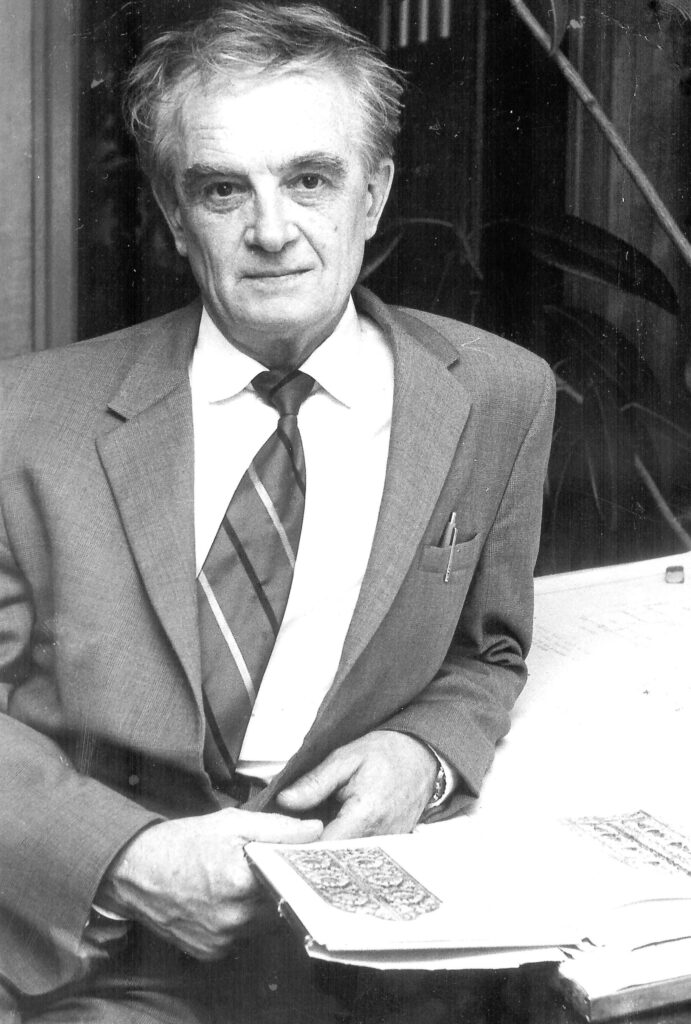
George (Yurii) Kodak was a Ukrainian/Canadian architect, artist, and sculptor. His architectural works include numerous Ukrainian Orthodox and Catholic churches, as well as iconostases that are standing today in Canada and the United States. He was employed as an architect in Canada’s Federal Department of Public Works for 14 years but is known mainly for his ecclesiastic design works. He was devoted to applying his knowledge of Ukrainian history and culture to the churches he designed in order, that they reflect Ukraine’s national historic past. Walter Daschko, Professor of Architecture, Toronto University (2005) refers to George (Yurii) Kodak’s collective ecclesiastical work as that of:
“….the most skilled and accomplished practitioner of the Neo-Ukrainian-Baroque style, hybridizing historical elements of Ukrainian architecture, with contemporary methods and materials.”
George, or Yurii as he was known in Ukrainian communities, designed, and in several cases supervised the construction of twelve Ukrainian churches, and six iconostases. His works can be found in Toronto, Hamilton, Grimsby, Burlington, Sudbury, Ottawa, Ontario; Lachine and Montreal, Quebec; Winnipeg, Manitoba; Regina, Saskatchewan; South Bound Brook, New Jersey; Hammond, Indiana, and Boston, Massachusetts, USA.
Although these buildings and constructions stand on Canadian and American soil, the spirit and talent and creativity that inspired them came from Ukraine where Yurii was born and educated. Yurii’s father was the noted Ukrainian classical writer, Stepan Vasylchenko (1879-1932).
He expected much of his son. In 1914, in a letter to his wife, Kylyna he writes:
“Love the boy, that he may grow for the glory of Ukraine.”
In 1982, Yurii Kodak received the Ukrainian Canadian Congress Award for his life-long contribution to the development of Ukrainian cultural and community life in Canada.
Note: Images are dynamic. By clicking on image, it will open in a Light Box enabling magnification (+) and examination of details.
Yurii Kodak graduated in 1940 from the Kyiv National Institute of Art, Faculty of Architecture, today called the National Academy of Visual Arts and Architecture. He studied under one of the notable founding members, Vasyl Krychevsky. The outbreak of WWII precluded Yurii working in his chosen profession in Ukraine, or even returning to his homeland since Stalin’s policy was to execute or send to Siberia any man, woman or child found outside of the Soviet Union at War’s end. More than two million Ukrainians and Russians were forcibly repatriated to the Soviets under the program called Operation Keelhaul (1944-47) to face exile, imprisonment and execution. Nicholas Bellam, in his book, The Last Secret, Leo Tolstoy’s book Victims of Yalta and the Hollywood movie, The Red Danube, all depict the fallacy of the Allies in their mission of forcible repatriation.
To prevent reprisals on their families still living in Ukraine, many refugees fleeing the Russians changed their names. Yurii did the same. He changed his name from Panasenko to Kodak, choosing the name of a 17th century Ukrainian fort on the Dnipro river.
Yurii’s talents in portraiture had helped him survive Germany’s POW camps. Later, in the DP (Displaced Persons) camps, warnings from Canadian military helped him and others survive attempted repatriations to the USSR. Preparing the refugees for emigration out of Germany, the DP camp officials, in Bayreuth, Germany assessed Yurii as an architect, and he was quickly accepted for immigration to Canada under a work contract. George arrived in Canada August 1949 and within three years was designing and supervising the construction of his first architectural project: St. Vladimir’s Ukrainian Orthodox Church in Hamilton, Ontario. Other church commissions followed.
In 1956, he moved to Ottawa where he began a 14 year career with Canada’s Department of Public Works, Construction Branch. When that Department was privatized, Yurii returned to freelance architectural work which included a wide variety of projects, from custom homes, to garden centres, to discotheques, to designing a half-acre courtyard in Ottawa’s tourist centre for the National Capital Commission. During this time, he continued ecclesiastic work designing, and in some instances, supervising the construction of churches, both Orthodox and Ukrainian Catholic as well as Bukovinian, Hellenic and Romanian.
Architecture was Yurii Kodak’s profession and his work, but it did not always allow for the full expression of his creativity, as church designs were often restricted by the financial limits of their parishes. The full expression of his personality, his values and vivid imagination, therefore came through the visual arts of painting and sculpting.
In addition to his work as an architect and artist, Yurii Kodak was active in Ukrainian community life in Hamilton, where he was President of the parish, and in Ottawa where with Glasnost and with the growing independence of Ukraine, many writers, poets, musicians and journalists from Ukraine were hosted by Yurii Kodak and his family. The reputation of Stepan Vasylchenko paved the way for these visitors to freely visit Yurii’s home where songs were sung, stories told and glasses lifted to toast peace and freedom for Ukraine.
